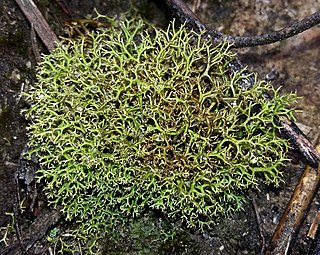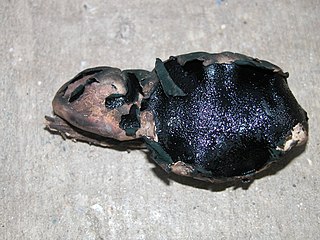
The Cladoniaceae are a family of lichenized fungi in the order Lecanorales. It is one of the largest families of lichen-forming fungi, with about 560 species distributed amongst 17 genera. The reindeer moss and cup lichens (Cladonia) belong to this family. The latter genus, which comprises about 500 species, forms a major part of the diet of large mammals in taiga and tundra ecosystems. Many Cladoniaceae lichens grow on soil, but other can use decaying wood, tree trunks, and, in a few instances, rocks as their substrate. They grow in places with high humidity, and cannot tolerate aridity.

Nectria is a genus of Ascomycete fungi. They are most often encountered as saprophytes on decaying wood but some species can also occur as parasites of trees, especially fruit trees and a number of other hardwood trees. Some species are significant pests causing diseases such as apple canker, Nectria twig blight, and coral spot in orchards.

The Ostropales are an order of fungi in the class Lecanoromycetes. The order was circumscribed by Swedish botanist John Axel Nannfeldt in 1932. The order contains 4 families and 46 genera, including 6 genera of uncertain familial placement.
Thysanothecium is a genus of three species of lichenized fungi in the family Cladoniaceae. The genus was circumscribed by Camille Montagne and Miles Joseph Berkeley in 1846. The original specimens of the type species, T. hookeri, were collected from the area of Swan River (Australia) by James Drummond, who sent them for to William Jackson Hooker for further analysis.
Squamella is a genus of lichenized fungi in the family Cladoniaceae. The genus is monotypic, containing the single species Squamella spumosa, which is found in Australia. Both the genus and species were described by Samuel Hammer in 2001.
Sphaerophoropsis is a genus of lichenized fungi in the family Cladoniaceae. A monotypic genus, Sphaerophoropsis contains the single species Sphaerophoropsis stereocauloides. Both the genus and species were described as new to science in 1890 by Finnish lichenologist Edvard August Vainio, from collections made in Brazil.

Pycnothelia is a genus of lichen-forming fungi in the family Cladoniaceae. Pycnothelia was promoted to generic status by French naturalist Léon Jean Marie Dufour in 1821; it was originally circumscribed by Erik Acharius in 1799 as a section of the now-defunct genus Cenomyce.

Pilophorus is a genus of lichenized fungi in the family Cladoniaceae. They are commonly known as matchstick lichens. The genus has a widespread distribution, especially in temperate regions, and contains 11 species.
Myelorrhiza is a genus of two Australian species of lichenized fungi in the family Ramalinaceae. It was circumscribed in 1986 by Australian lichenologists Doug Verdon and John A. Elix. Myelorrhiza was originally classified in the family Cladoniaceae until Kistenich and colleagues, using molecular phylogenetic analysis, showed that it is more appropriately placed with the Ramalinaceae.
Metus is a genus of three species of lichenized fungi in the family Cladoniaceae. The genus was circumscribed by lichenologists David John Galloway and Peter Wilfred James in 1987, with Metus conglomeratus as the type species. All three species are found in the Southern Hemisphere.
Heteromyces is a genus of lichenized fungi in the family Cladoniaceae. It is a monotypic genus, containing the single species Heteromyces rubescens. Both the genus and species were described by Swiss lichenologist Johannes Müller Argoviensis in 1889. The name Heteromyces was also used for a genus circumscribed by Lindsay S. Olive in 1957; this usage is illegitimate because of the prior usage of this name by Müller. Olive's concept of Heteromyces was renamed to Oliveonia by Marinus Anton Donk in 1958.
Gymnoderma is a genus of lichen-forming fungi in the family Cladoniaceae. It has three species. The genus was circumscribed by Finnish botanist William Nylander in 1860. Nylander assigned Gymnoderma coccocarpum as the type species in 1869; this species was originally collected from the Himalayas. It occurs throughout southeastern Asia.

Cladia is a genus of lichen-forming fungi in the family Cladoniaceae. Cladia species have a crustose or squamulose (scaly) primary thallus and a fruticose, secondary thallus, often referred to as pseudopodetium. The type species of the genus, Cladia aggregata, is widely distributed, occurring in South America, South Africa, Australasia and South-East Asia to southern Japan and India. Most of the other species are found in the Southern Hemisphere.
Carassea is a genus of lichenized fungi in the family Cladoniaceae. The genus was circumscribed in 2002 by Finnish lichenologist Soili Stenroos. A monotypic genus, Carassea contains the single species Carassea connexa. This species, originally named Cladonia connexa, was first documented by Edvard August Wainio, who collected specimens from Minas Gerais, Brazil, in 1885, and published a description of the species in the first of his three-volume Monographia Cladoniarum universalis. The Cladoniaceae genera most closely related to Carassea include Pycnothelia and Metus.

The Boliniaceae are a family of fungi in the Boliniales order. The family consisted of seven genera and 40 species in 2008. A new study found more genera and species in 2020.

Ophioparma is a genus of crustose lichens in the family Ophioparmaceae.
Neophyllis a genus of lichenized fungi in the order Lecanorales. The genus contains two species found in Australasia. Originally classified in the family Cladoniaceae, the genus was transferred to the Sphaerophoraceae in 1999.

Pulchrocladia is a genus of fruticose lichens in the family Cladoniaceae. It has three species. The genus was circumscribed in 2018 by lichenologists Soili Stenroos, Raquel Pino-Bodas, Helge Thorsten Lumbsch, and Teuvo Ahti. The genus name refers to "the beautiful morphology of its species".
Paralecia is a monotypic fungal genus in the family Cladoniaceae. It contains a single species, the lichenicolous fungus Paralecia pratorum, found in Europe.

Carbonicola is a small genus of lichen-forming fungi. It is the sole genus in the monogeneric family Carbonicolaceae. The genus, which collectively has an almost cosmopolitan distribution, contains three squamulose lichens that prefer to grow on burned wood in temperate areas of the world.









